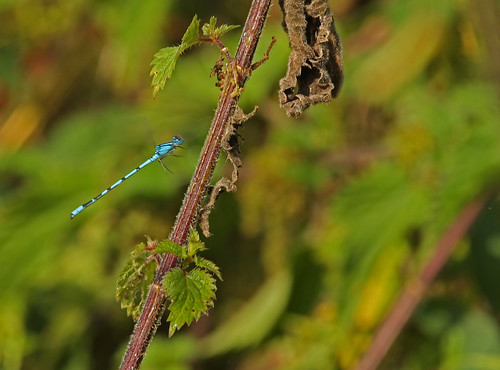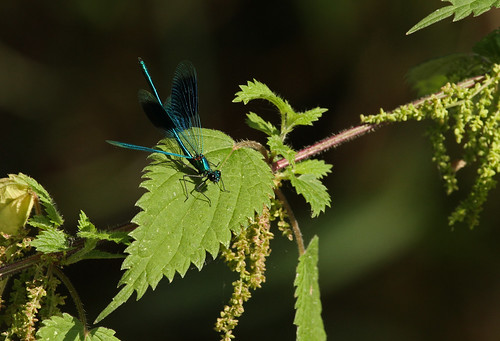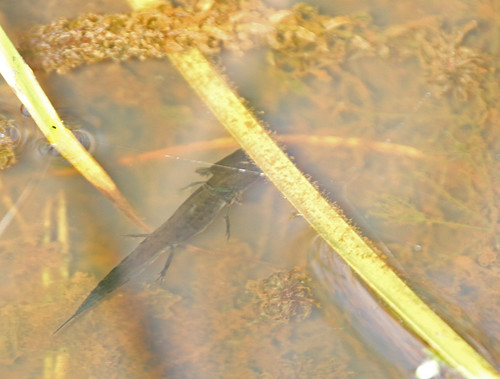Early last Saturday morning I set off for Paxton Pits, a group of lakes on the edge of St Neots, between Bedford and Cambridge. It was anticapted that we wouldn’t see much birdlife but there could be some inteersting dragonfly activity. And apart from a lone turtle dove (which justifies the trip on its own!) and a sparrowhawk, we noticed surprisingly few birds. But the Odanata were there in abundance with large numbers of various species of damsels and true dragons.
I spotted this common blue (Enallagma cyathigerum) before I’d even got out the car. This one a male, was perched on a seed head at the edge of the carpark and there were several others in the vicinity warming themselves up in the early morning sunshine. At the other side of the carpark is the visitor centre which has a small pond outside and over the pond were a red eyed damsel (Erythromma najas) and another common blue warming up on the same rush leaf:
Paxton Pits are disused gravel workings and have been turned into a nature reserve that is managed by Huntingdonshire District Council with the back up of the voluteers of the ‘Friends of Paxton Pits’. If you happen to be contemplating a visit to the Pits, there is a lot of information on their website: (https://sites.google.com/site/paxtonpitsnaturereserve/home), and the reserve also has a blog where sightings at the lakes can be recorded: (http://paxtonpits.blogspot.co.uk/). The website lists all the Odanata that have been resident there and many of them were on display on Saturday. They don’t all emerge at the same time of year so it would never be possible to see all of them during one visit.

Another common blue damsel on final approach to land on a stinging nettle stem
The Pits are adjacent to the River Great Ouse and swarms (literally!) of banded demoiselles (Calopteryx splendens) were fluttering within 20m or so of the banks of the river. The banded demoiselle is one of two species of demoiselle in the UK and the only one in the east of England, and I think they’re absolutely beautiful as they sparkle in direct sunlight:
 A female banded demoiselle perched on top of a nettle (I like the background here – out of focus brambles)
A female banded demoiselle perched on top of a nettle (I like the background here – out of focus brambles)
The other species of UK demoiselle is called the ‘beautiful demoiselle’ (Calopteryx virgo) and is found in the south and west but not the east. It is most easily distinguished from the banded version because the wing pigmentation in the male extends to the base of the wing, so it’s a much bigger spot than those on the wings of these banded demoiselles:
 Above and below: male banded demoiselles
Above and below: male banded demoiselles

And the female beautiful demoiselle has broader wings with a brown tint that’s lacking in the banded demoiselle. The male demoiselles were busy chasing females with all thoughts turned to mating.
But in the midst of all the the mating activity, danger, as always, was lurking in the undergrowth. This unfortunate female common blue damsel had been caught in a spider web and was in the midst of a mortal struggle with the owner, which she eventually lost:
The male common blue was also caught in the web and was struggling to extricate himself. Fortunately for him, all the spiders efforts were needed to subdue the female and whilst it was otherwise distracted he made his escape whilst the female eventually succumbed to the spider venom.
 A dragonfly larva having scaled a stem to leave the water will shortly burst out of its skin and fly off as an adult dragon
A dragonfly larva having scaled a stem to leave the water will shortly burst out of its skin and fly off as an adult dragon
It’s also that time of year when dragonfly larvae are metamorphosing into adults. The larval stage of all dragonflies is aquatic and so they require gills or ‘caudal lamellae‘ to breath underwater, and these can be seen protruding from the end of the abdomen of the larva above. At the end of its aquatic life the larva climbs a stem out of the water and emerges from its larval skin as an adult, leaving behind its discarded outer casing, or ‘exuvia‘:
 Dragonfly exuvia – a dried out larval husk left behind on a rush stem after the new adult has flown
Dragonfly exuvia – a dried out larval husk left behind on a rush stem after the new adult has flown
As well as the damsels, several species of true dragons were on the wing including brown hawker, migrant hawker, black tailed skimmer, and the grandaddy of all UK dragons, the emperor (Anax imperator):
 Emperor dragonfly male patrolling his stretch of water against allcomers
Emperor dragonfly male patrolling his stretch of water against allcomers
The emperor, as its name suggests, is a whopper. It is also an aggressive defender of its territory, a consummate aeronaut and a ferocious hunter, taking prey as big as other dragonflies. It’s easily distinguished from other dragons by its sheer bulk, the apple green thorax and the drooping abdomen. I sat and watched this one for some time and he rewarded my patience by posing for a portrait on a stem just a few metres away:
And after all the dragon activity I peered into the water on the way home and spotted this little chap:
I don’t know what species of newt this is but it’s still so young it hasn’t adapted to air breathing and still has its feathery gills which are visible just in front of the fore legs.
It’s been a long time since I last posted so it’s good to be back Life should be generally less busy for the back end of the year and I’ve got lots to share, so hopefully I can start to post more regularly again!








